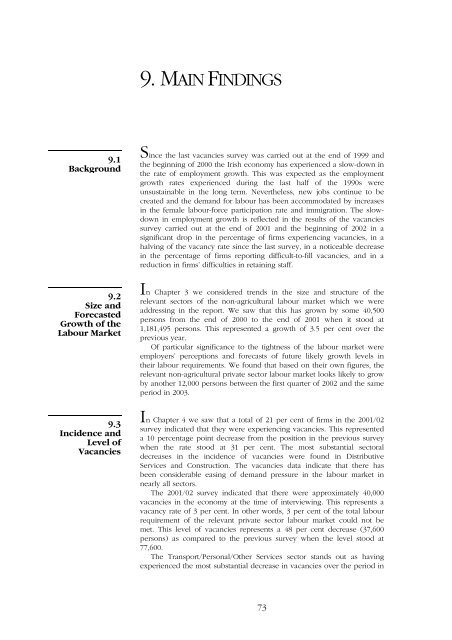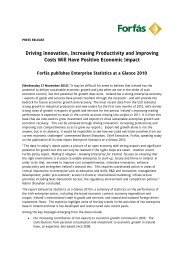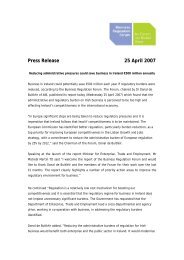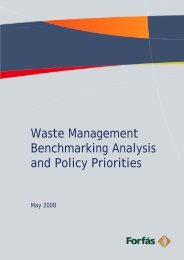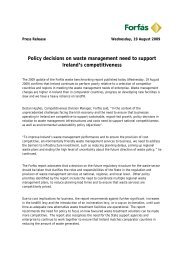National Survey of Vacancies in the Private (Non ... - Forfás
National Survey of Vacancies in the Private (Non ... - Forfás
National Survey of Vacancies in the Private (Non ... - Forfás
Create successful ePaper yourself
Turn your PDF publications into a flip-book with our unique Google optimized e-Paper software.
9.1<br />
Background<br />
9.2<br />
Size and<br />
Forecasted<br />
Growth <strong>of</strong> <strong>the</strong><br />
Labour Market<br />
9.3<br />
Incidence and<br />
Level <strong>of</strong><br />
<strong>Vacancies</strong><br />
9. MAIN FINDINGS<br />
S<strong>in</strong>ce <strong>the</strong> last vacancies survey was carried out at <strong>the</strong> end <strong>of</strong> 1999 and<br />
<strong>the</strong> beg<strong>in</strong>n<strong>in</strong>g <strong>of</strong> 2000 <strong>the</strong> Irish economy has experienced a slow-down <strong>in</strong><br />
<strong>the</strong> rate <strong>of</strong> employment growth. This was expected as <strong>the</strong> employment<br />
growth rates experienced dur<strong>in</strong>g <strong>the</strong> last half <strong>of</strong> <strong>the</strong> 1990s were<br />
unsusta<strong>in</strong>able <strong>in</strong> <strong>the</strong> long term. Never<strong>the</strong>less, new jobs cont<strong>in</strong>ue to be<br />
created and <strong>the</strong> demand for labour has been accommodated by <strong>in</strong>creases<br />
<strong>in</strong> <strong>the</strong> female labour-force participation rate and immigration. The slowdown<br />
<strong>in</strong> employment growth is reflected <strong>in</strong> <strong>the</strong> results <strong>of</strong> <strong>the</strong> vacancies<br />
survey carried out at <strong>the</strong> end <strong>of</strong> 2001 and <strong>the</strong> beg<strong>in</strong>n<strong>in</strong>g <strong>of</strong> 2002 <strong>in</strong> a<br />
significant drop <strong>in</strong> <strong>the</strong> percentage <strong>of</strong> firms experienc<strong>in</strong>g vacancies, <strong>in</strong> a<br />
halv<strong>in</strong>g <strong>of</strong> <strong>the</strong> vacancy rate s<strong>in</strong>ce <strong>the</strong> last survey, <strong>in</strong> a noticeable decrease<br />
<strong>in</strong> <strong>the</strong> percentage <strong>of</strong> firms report<strong>in</strong>g difficult-to-fill vacancies, and <strong>in</strong> a<br />
reduction <strong>in</strong> firms’ difficulties <strong>in</strong> reta<strong>in</strong><strong>in</strong>g staff.<br />
In Chapter 3 we considered trends <strong>in</strong> <strong>the</strong> size and structure <strong>of</strong> <strong>the</strong><br />
relevant sectors <strong>of</strong> <strong>the</strong> non-agricultural labour market which we were<br />
address<strong>in</strong>g <strong>in</strong> <strong>the</strong> report. We saw that this has grown by some 40,500<br />
persons from <strong>the</strong> end <strong>of</strong> 2000 to <strong>the</strong> end <strong>of</strong> 2001 when it stood at<br />
1,181,495 persons. This represented a growth <strong>of</strong> 3.5 per cent over <strong>the</strong><br />
previous year.<br />
Of particular significance to <strong>the</strong> tightness <strong>of</strong> <strong>the</strong> labour market were<br />
employers’ perceptions and forecasts <strong>of</strong> future likely growth levels <strong>in</strong><br />
<strong>the</strong>ir labour requirements. We found that based on <strong>the</strong>ir own figures, <strong>the</strong><br />
relevant non-agricultural private sector labour market looks likely to grow<br />
by ano<strong>the</strong>r 12,000 persons between <strong>the</strong> first quarter <strong>of</strong> 2002 and <strong>the</strong> same<br />
period <strong>in</strong> 2003.<br />
In Chapter 4 we saw that a total <strong>of</strong> 21 per cent <strong>of</strong> firms <strong>in</strong> <strong>the</strong> 2001/02<br />
survey <strong>in</strong>dicated that <strong>the</strong>y were experienc<strong>in</strong>g vacancies. This represented<br />
a 10 percentage po<strong>in</strong>t decrease from <strong>the</strong> position <strong>in</strong> <strong>the</strong> previous survey<br />
when <strong>the</strong> rate stood at 31 per cent. The most substantial sectoral<br />
decreases <strong>in</strong> <strong>the</strong> <strong>in</strong>cidence <strong>of</strong> vacancies were found <strong>in</strong> Distributive<br />
Services and Construction. The vacancies data <strong>in</strong>dicate that <strong>the</strong>re has<br />
been considerable eas<strong>in</strong>g <strong>of</strong> demand pressure <strong>in</strong> <strong>the</strong> labour market <strong>in</strong><br />
nearly all sectors.<br />
The 2001/02 survey <strong>in</strong>dicated that <strong>the</strong>re were approximately 40,000<br />
vacancies <strong>in</strong> <strong>the</strong> economy at <strong>the</strong> time <strong>of</strong> <strong>in</strong>terview<strong>in</strong>g. This represents a<br />
vacancy rate <strong>of</strong> 3 per cent. In o<strong>the</strong>r words, 3 per cent <strong>of</strong> <strong>the</strong> total labour<br />
requirement <strong>of</strong> <strong>the</strong> relevant private sector labour market could not be<br />
met. This level <strong>of</strong> vacancies represents a 48 per cent decrease (37,600<br />
persons) as compared to <strong>the</strong> previous survey when <strong>the</strong> level stood at<br />
77,600.<br />
The Transport/Personal/O<strong>the</strong>r Services sector stands out as hav<strong>in</strong>g<br />
experienced <strong>the</strong> most substantial decrease <strong>in</strong> vacancies over <strong>the</strong> period <strong>in</strong><br />
73


